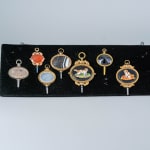A COLLECTION OF GEORGIAN POCKET WATCH KEYS , English, date circa 1820
A superb collection of twenty-four George IV pocket watch winding keys, some enclosing semi-precious stones set within oval frames, another pair of the same shape enclosing semi-precious stone mosaic portraits of a pair of spaniels, one with a silver medallion inscribed with the initials L. D. C, others shaped as a walking stick as well as a man dressed in Eastern costume, in addition to others of various intricate shapes and designs. All arranged upon black cloth and mounted upon a pair of boards
English, date circa 1820
This fine collection of pocket watch winding keys date from about 1820, the year in which the Prince Regent was crowned George IV of England. Together, they represent the diversity of ornate shapes and design and variety of materials that were used to create these small keys. At that time pocket watches were not only considered useful but were a status symbol to be shown off to the public. They were also of great value, so much so that if such a watch was lost or stolen, large rewards were often offered for the retrieval of the property.
The first pocket watches were invented in sixteenth century Europe. Originating from the early ‘verge’ watches, they were essentially miniature versions of church or turret clocks and were often bulbous, and their casings at one time were described as ‘onions’, partly due to the shape but also due to their multiple layers. By about 1700 their form evolved into the typical pocket watch shape, rounded and flattened with no sharp edges so that gentlemen could easily fit them into their pockets instead of wearing them as pendants.
Up until the mid nineteenth century, all pocket watches were wound by the means of a key so as to maintain the going power and to set the correct time. This was usually done by opening the case back and putting the key over the winding-arbor (which was set over the watch’s winding-wheel, to wind the mainspring) or by putting the key onto the setting-arbor, which was connected with the minute-wheel and turned the hands. Some of the earliest watches had the setting-arbor at the front of the watch, so that removing the glazed dial cover and bezel was necessary to set the time. The first keys were simple, T-shaped pieces of metal, but over time, they became more ornate and decorative. Key sizes varied since they had to fit the different size arbors on the watch. They were usually about an inch and a half (c. 3.5 cm.) in length and were attached to the pocket watch with a chain or chatelaine, usually made of gold.
Key wound pocket watches remained largely in use up until the mid nineteenth century but then fell in decline after 1842, when Adrien Philippe invented the stem wound watch. This devise was then commercialized by Patek Philippe & Co in the 1850s. These watches required the owner to turn a small handle on a stem so as to wind the watch up. A later version of a stem wind watch involved a lever which was pulled out and turned, so as to set the time and wind the watch. During World War I, wristwatches became increasingly more popular and largely ended the demand for the traditional pocket watch. Despite this, the allure for the pocket watch and their winding keys still persists today.



